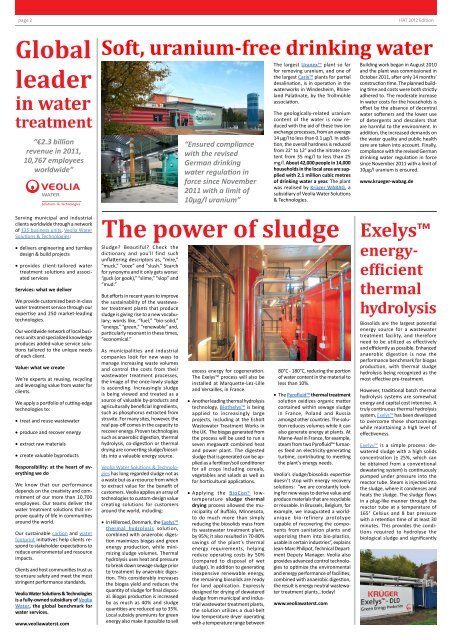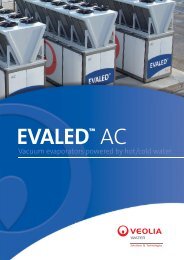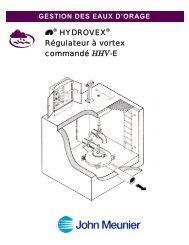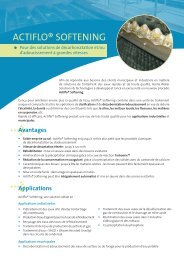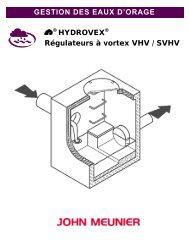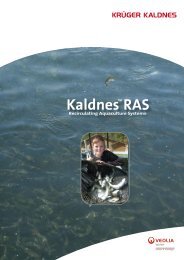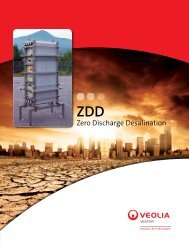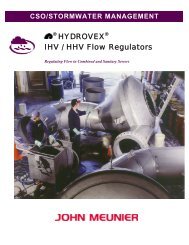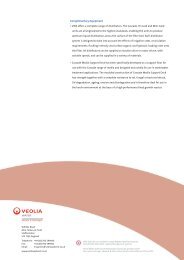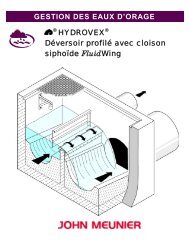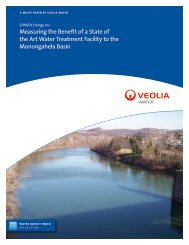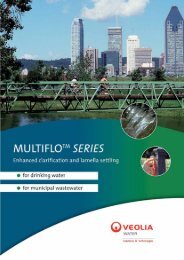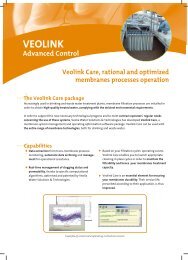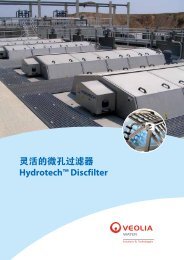IFAT Trade Show 2012 - Veolia Water Ireland
IFAT Trade Show 2012 - Veolia Water Ireland
IFAT Trade Show 2012 - Veolia Water Ireland
Create successful ePaper yourself
Turn your PDF publications into a flip-book with our unique Google optimized e-Paper software.
page 2<br />
<strong>IFAT</strong> <strong>2012</strong> Edition<br />
Global<br />
Soft, uranium-free drinking water<br />
leader<br />
in water<br />
treatment<br />
“€2.3 billion<br />
revenue in 2011,<br />
10,767 employees<br />
worldwide”<br />
“Ensured compliance<br />
with the revised<br />
German drinking<br />
water regulation in<br />
force since November<br />
2011 with a limit of<br />
10μg/l uranium”<br />
The largest Uranex plant so far<br />
for removing uranium, and one of<br />
the largest Carix plants for partial<br />
desalination, is in operation in the<br />
waterworks in Windesheim, Rhineland<br />
Palatinate, by the Trollmühle<br />
association.<br />
The geologically-related uranium<br />
content of the water is now reduced<br />
with the aid of these two ion<br />
exchange processes, from an average<br />
14 μg/l to less than 0.1 μg/l. In addition,<br />
the overall hardness is reduced<br />
from 22° to 12° and the nitrate content<br />
from 35 mg/l to less than 25<br />
mg/l. About 42,000 people in 14,000<br />
households in the local area are supplied<br />
with 2.1 million cubic metres<br />
of drinking water a year. The plant<br />
was realised by Krüger WABAG, a<br />
subsidiary of <strong>Veolia</strong> <strong>Water</strong> Solutions<br />
& Technologies.<br />
Building work began in August 2010<br />
and the plant was commissioned in<br />
October 2011, after only 14 months’<br />
construction time. The planned building<br />
time and costs were both strictly<br />
adhered to. The moderate increase<br />
in water costs for the households is<br />
offset by the absence of decentral<br />
water softeners and the lower use<br />
of detergents and descalers that<br />
are harmful to the environment. In<br />
addition, the increased demands on<br />
the water quality and public health<br />
care are taken into account. Finally,<br />
compliance with the revised German<br />
drinking water regulation in force<br />
since November 2011 with a limit of<br />
10μg/l uranium is ensured.<br />
www.krueger-wabag.de<br />
Serving municipal and industrial<br />
clients worldwide through a network<br />
of 135 business units, <strong>Veolia</strong> <strong>Water</strong><br />
Solutions & Technologies:<br />
• delivers engineering and turnkey<br />
design & build projects<br />
• provides client-tailored water<br />
treatment solutions and associated<br />
services<br />
Services: what we deliver<br />
We provide customized best-in-class<br />
water treatment service through our<br />
expertise and 250 market-leading<br />
technologies.<br />
Our worldwide network of local business<br />
units and specialized knowledge<br />
produces added-value service solutions<br />
tailored to the unique needs<br />
of each client.<br />
Value: what we create<br />
We’re experts at reusing, recycling<br />
and leveraging value from water for<br />
clients.<br />
We apply a portfolio of cutting-edge<br />
technologies to:<br />
• treat and reuse wastewater<br />
• produce and recover energy<br />
• extract raw materials<br />
• create valuable byproducts<br />
Responsibility: at the heart of everything<br />
we do<br />
We know that our performance<br />
depends on the creativity and commitment<br />
of our more than 10,700<br />
employees. Our teams deliver the<br />
water treatment solutions that improve<br />
quality of life in communities<br />
around the world.<br />
Our sustainable carbon and water<br />
footprint initiatives help clients respond<br />
to stakeholder expectations to<br />
reduce environmental and resource<br />
impacts.<br />
Clients and host communities trust us<br />
to ensure safety and meet the most<br />
stringent performance standards.<br />
<strong>Veolia</strong> <strong>Water</strong> Solutions & Technologies<br />
is a fully-owned subsidiary of <strong>Veolia</strong><br />
<strong>Water</strong>, the global benchmark for<br />
water services.<br />
www.veoliawaterst.com<br />
The power of sludge<br />
Sludge? Beautiful? Check the<br />
dictionary and you’ll find such<br />
unflattering descriptors as, “mire,”<br />
“muck,” “ooze” and “slush.” Search<br />
for synonyms and it only gets worse:<br />
“guck (or gook),” “slime,” “slop” and<br />
“mud.”<br />
But efforts in recent years to improve<br />
the sustainability of the wastewater<br />
treatment plants that produce<br />
sludge is giving rise to a new vocabulary;<br />
words like, “fuel,” “bio-solid,”<br />
“energy,” “green,” “renewable” and,<br />
particularly resonant in these times,<br />
“economical.”<br />
As municipalities and industrial<br />
companies look for new ways to<br />
manage increasing waste volumes<br />
and control the costs from their<br />
wastewater treatment processes,<br />
the image of the once-lowly sludge<br />
is ascending. Increasingly sludge<br />
is being viewed and treated as a<br />
source of valuable by-products and<br />
agriculturally beneficial ingredients,<br />
such as phosphorus extracted from<br />
struvite. For many sites, however, the<br />
real pay-off comes in the capacity to<br />
recover energy. Proven technologies<br />
such as anaerobic digestion, thermal<br />
hydrolysis, co-digestion or thermal<br />
drying are converting sludge/biosolids<br />
into a valuable energy source.<br />
<strong>Veolia</strong> <strong>Water</strong> Solutions & Technologies<br />
has long regarded sludge not as<br />
a waste but as a resource from which<br />
to extract value for the benefit of<br />
customers. <strong>Veolia</strong> applies an array of<br />
technologies to custom-design value<br />
creating solutions for customers<br />
around the world, including:<br />
• In Hilleroed, Denmark, the Exelys<br />
thermal hydrolysis solution,<br />
combined with anaerobic digestion<br />
maximizes biogas and green<br />
energy production, while minimizing<br />
sludge volumes. Thermal<br />
hydrolysis uses heat and pressure<br />
to break down sewage sludge prior<br />
to treatment by anaerobic digestion.<br />
This considerably increases<br />
the biogas yield and reduces the<br />
quantity of sludge for final disposal.<br />
Biogas production is increased<br />
by as much as 40% and sludge<br />
quantities are reduced up to 35%.<br />
Local subsidy premiums for green<br />
energy also make it possible to sell<br />
excess energy for cogeneration.<br />
The Exelys process will also be<br />
installed at Marquette-Lez-Lille<br />
and Versailles, in France.<br />
• Another leading thermal hydrolysis<br />
technology, Biothelys is being<br />
applied to increasingly large<br />
projects, including at the Esholt<br />
Wastewater Treatment Works in<br />
the UK. The biogas generated from<br />
the process will be used to run a<br />
seven megawatt combined heat<br />
and power plant. The digested<br />
sludge that is generated can be applied<br />
as a fertilizer/soil conditioner<br />
for all crops including cereals,<br />
vegetables and salads as well as<br />
for horticultural applications.<br />
• Applying the BioCon® lowtemperature<br />
sludge thermal<br />
drying process allowed the municipality<br />
of Buffalo, Minnesota,<br />
to do much more than simply<br />
reducing the biosolids mass from<br />
its wastewater treatment plant,<br />
by 95%; it also resulted in 70-80%<br />
savings of the plant’s thermal<br />
energy requirements, helping<br />
reduce operating costs by 50%<br />
(compared to disposal of wet<br />
sludge). In addition to generating<br />
inexpensive renewable energy,<br />
the remaining biosolids are ready<br />
for land application. Expressly<br />
designed for drying of dewatered<br />
sludge from municipal and industrial<br />
wastewater treatment plants,<br />
the solution utilizes a dual-belt<br />
low temperature dryer operating<br />
with a temperature range between<br />
80°C - 180°C, reducing the portion<br />
of water content in the material to<br />
less than 10%.<br />
• The Pyrofluid thermal treatment<br />
solution oxidizes organic matter<br />
contained within sewage sludge<br />
in France, Poland and Russia<br />
amongst other countries. The solution<br />
reduces volumes while it can<br />
also generate energy at plants. At<br />
Marne-Aval in France, for example,<br />
steam from two Pyrofluid furnaces<br />
feed an electricity-generating<br />
turbine, contributing to meeting<br />
the plant’s energy needs.<br />
<strong>Veolia</strong>’s sludge/biosolids expertise<br />
doesn’t stop with energy recovery<br />
solutions: “we are constantly looking<br />
for new ways to derive value and<br />
produce materials that are recyclable<br />
or reusable. In Brussels, Belgium, for<br />
example, we inaugurated a worldunique<br />
bio-refinery prototype<br />
capable of recovering the components<br />
from sanitation plants and<br />
vaporizing them into bio-plastics,<br />
usable in certain industries”, explains<br />
Jean-Marc Philipot, Technical Department<br />
Deputy Manager. <strong>Veolia</strong> also<br />
provides advanced control technologies<br />
to optimize the environmental<br />
and energy performance of facilities;<br />
combined with anaerobic digestion,<br />
the result is energy neutral wastewater<br />
treatment plants…today!<br />
www.veoliawaterst.com<br />
Exelys<br />
energyefficient<br />
thermal<br />
hydrolysis<br />
Biosolids are the largest potential<br />
energy source for a wastewater<br />
treatment facility, and therefore<br />
need to be utilized as effectively<br />
and efficiently as possible. Enhanced<br />
anaerobic digestion is now the<br />
performance benchmark for biogas<br />
production, with thermal sludge<br />
hydrolysis being recognized as the<br />
most effective pre-treatment.<br />
However, traditional batch thermal<br />
hydrolysis systems are somewhat<br />
energy and capital cost intensive. A<br />
truly continuous thermal hydrolysis<br />
system, Exelys has been developed<br />
to overcome these shortcomings<br />
while maintaining a high level of<br />
effectiveness.<br />
Exelys is a simple process: dewatered<br />
sludge with a high solids<br />
concentration (± 25%, which can<br />
be obtained from a conventional<br />
dewatering system) is continuously<br />
pumped under pressure into the<br />
reactor tube. Steam is injected into<br />
the sludge, where it condenses and<br />
heats the sludge. The sludge flows<br />
in a plug-like manner through the<br />
reactor tube at a temperature of<br />
165° Celsius and 8 bar pressure<br />
with a retention time of at least 30<br />
minutes. This provides the conditions<br />
required to hydrolyse the<br />
biological sludge and significantly


